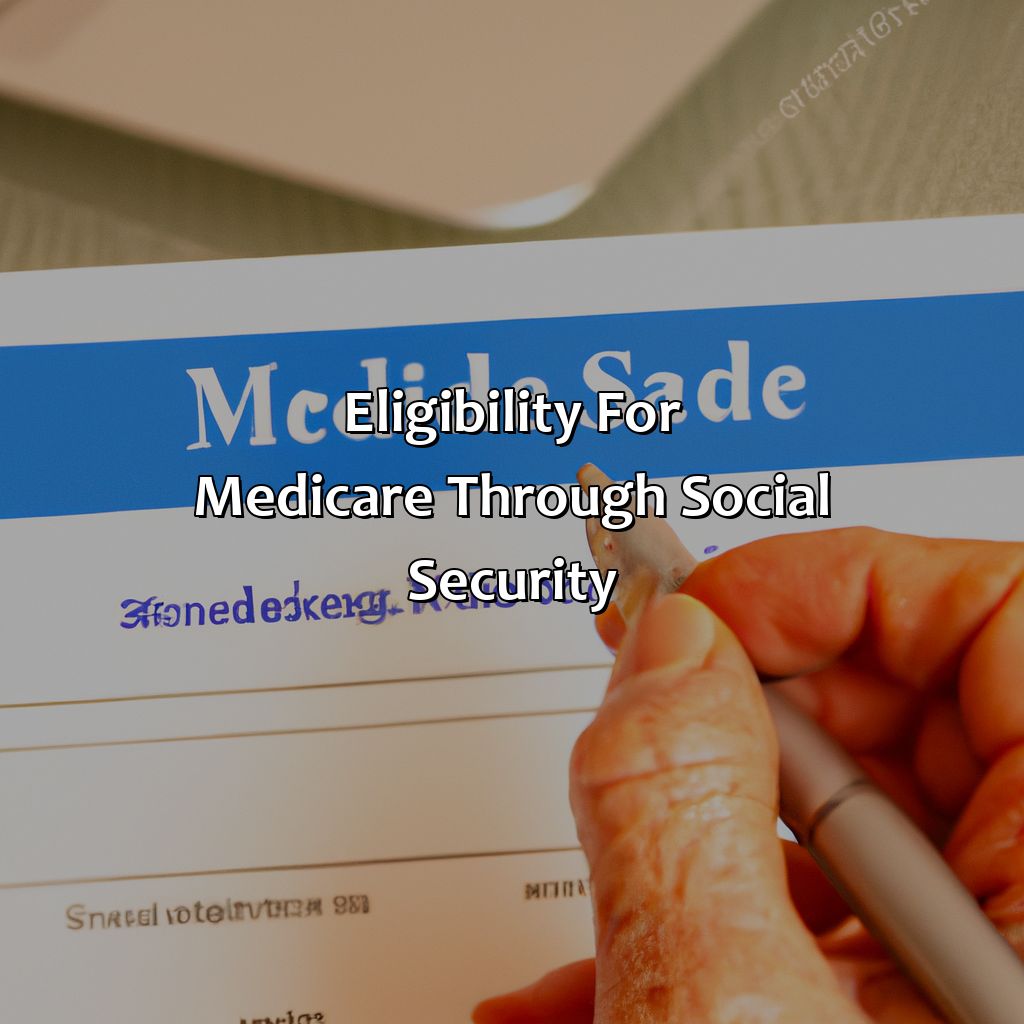How To Sign Up For Medicare Through Social Security?
Key Takeaway:
- Medicare through Social Security is available for those who meet age or disability requirements, and it is important to understand eligibility criteria before signing up.
- There are three ways to sign up for Medicare through Social Security, including online registration, in-person registration, and phone registration, so choose the method that is most convenient for you.
- When registering for Medicare through Social Security, you will need to provide proof of identity, proof of citizenship or legal residency, and information about your employer and insurance, so make sure to have these documents ready.
- Enrollment periods for Medicare through Social Security are divided into initial enrollment, general enrollment, and special enrollment, so familiarize yourself with these periods to avoid penalties for late enrollment.
- Additional tips for signing up for Medicare through Social Security include researching plan options and costs, considering supplemental coverage, and understanding penalties for late enrollment to ensure a smooth and successful enrollment process.
Are you confused about the process for signing up for Medicare? Don’t worry! This article will help you understand the steps involved and show you how to navigate the Social Security website to sign up. You can easily get the help you need to make sure you’re taking the right steps.
Eligibility for Medicare through Social Security
To see if you qualify for Medicare through Social Security, two options will be looked at. Those two options are Age and Disability requirements.

Image credits: retiregenz.com by Joel Duncun
Age requirements
To qualify for Medicare benefits, there are certain age requirements that must be met. Generally, individuals who are 65 or older are eligible for Medicare. However, those who have been receiving disability benefits for at least 24 months may also qualify.
When you turn 65, you will automatically be enrolled in Medicare if you are already receiving Social Security benefits. Otherwise, you will need to sign up during the initial enrollment period to avoid any late enrollment penalties. It is important to note that if you delay signing up for Medicare Part B after your initial enrollment period ends, you may face a permanent increase in premiums.
It’s essential to understand the eligibility criteria and enroll in Medicare on time. To sign up for Medicare through Social Security, visit the official website or visit your local Social Security office.
Pro Tip: If you’re unsure about your eligibility or have any questions regarding enrolling in Medicare, contact a licensed insurance agent who can guide you through the entire process.
Unfortunately, having a disability doesn’t make you eligible for a participation trophy, but it does qualify you for Medicare through Social Security.
Disability requirements
To be eligible for Medicare through Social Security due to disability, individuals must have received Social Security Disability Insurance for at least 24 months or have a diagnosis of End-Stage Renal Disease or Amyotrophic Lateral Sclerosis. Upon meeting these requirements, individuals can enroll in Medicare Part A and B through the Social Security Administration. It’s important to note that those who qualify for Medicare based on disability may also be eligible for additional assistance programs such as Medicaid.
Pro Tip: Individuals who receive SSDI should enroll in Medicare during their Initial Enrollment Period to avoid late enrollment penalties.
Signing up for Medicare through Social Security is easier than winning the lottery, but with better odds of actually getting what you need.
Ways to sign up for Medicare through Social Security
Let’s explore how to sign up for Medicare through Social Security! We’ve divided the info into 3 sub-sections: Online, In-Person, Phone. Get a clear picture with this guide!

Image credits: retiregenz.com by Yuval Duncun
Online registration
The process of enrolling in Medicare online is easy and convenient. Here’s what you need to know about the online registration process:
- Visit Social Security’s website.
- Select ‘Medicare’ from the drop-down menu on the homepage.
- Go to the ‘Apply for Medicare’ section and click ‘Get Started’.
- Make sure you have all the necessary documents, including proof of age, citizenship, and previous health insurance enrollment.
- Complete your application online by following the instructions on each screen carefully.
- Once you’ve completed your application, submit it electronically.
In addition to these six steps, it is essential to review your information before submitting your application. Also, ensure that everything you have entered is accurate and up-to-date.
Did you know that if you don’t sign up for Medicare when you’re eligible, your premiums may increase? According to government sources, there is a late enrollment penalty of 10% of your Part B premium for every year that passes without coverage.
If you want to try your luck with government bureaucracy, sign up for Medicare in person at your local Social Security office.
In-person registration
For those who prefer a more hands-on approach, Medicare registration can be completed in person. Here’s how to register for Medicare through Social Security in-person.
- Locate the nearest Social Security office by visiting their website or calling their toll-free number.
- Schedule an appointment to meet with a representative and bring necessary documents such as your birth certificate and proof of income.
- Fill out the proper paperwork at the appointment time with the assistance of the representative.
- Receive confirmation and additional information via mail regarding your enrollment and coverage options.
If you’re unable to register online or want to ensure that all necessary documents are included, in-person registration may be the best option for you. Make sure to schedule an appointment ahead of time and arrive prepared with all required documents.
It’s important to note that not all Social Security offices offer walk-in appointments, so it’s best to call ahead or schedule an appointment online.
According to Medicare.gov, “You have a 7-month initial enrollment period that starts 3 months before the month you turn 65, includes the month you turn 65, and ends 3 months after the month you turn 65.” So make sure to register during your designated enrollment period!
According to Forbes, “In 2021, Medicare covered roughly 63 million people — including more than nine million younger adults with permanent disabilities.”
Calling Social Security for Medicare enrollment is like playing phone tag with a government agent who only works on Fridays.
Phone registration
When registering for Medicare through Social Security, one option you have is to sign up via a phone call with a Social Security representative. This is a convenient way to enroll in Medicare without having to visit an office in person.
During the phone call, you will need to provide your personal information and answer questions about your eligibility for Medicare. The representative will then assist you in selecting the appropriate Medicare coverage options that meet your needs.
It’s important to note that this option may not be available during busy times and it could take several weeks before your enrollment is processed. However, if you prefer not to register online or in-person, this could be the best choice for you.
According to medicare.gov, “Social Security handles Medicare enrollment. You can apply for Medicare online or contact Social Security at 1-800-772-1213 (TTY users 1-800-325-0778) Monday through Friday from 7AM to 7PM“.
Get ready to hunt for those elusive documents like it’s the last golden ticket to Willy Wonka’s chocolate factory.
Documents required for Medicare registration
Registering for Medicare through Social Security can be easy – if you have the right documents. Without them, you might experience delays or even be denied benefits. Here’s what you need to know:
- You’ll need proof of identity
- You’ll need proof of citizenship/residency
- You’ll need employer/insurance info

Image credits: retiregenz.com by Yuval Arnold
Proof of identity
To complete Medicare registration, one needs to provide valid proof of their identity. This can include a valid driver’s license, state ID card, or passport. The document must be current and display the person’s full legal name, date of birth, and photograph.
It is essential to ensure that these documents are not expired or altered in any way. If they are, they will not be accepted as proof of identity. Additionally, if you have changed your name, provide proof of the name change with documents like marriage licenses or court orders.
Medicare registration requires various other documents besides valid proof of identity, such as financial information and healthcare insurance details. Ensure you have all necessary documents before starting the registration process.
According to Medicare.gov, over 63 million people were enrolled in Medicare in 2020. They say honesty is the best policy, but for Medicare registration, proof of citizenship or legal residency is even better.
Proof of citizenship or legal residency
When registering for Medicare, it is essential to provide proof of your citizenship or legal residency. This can be done by presenting a valid US passport or birth certificate to the Social Security Administration.
It is important to note that if you are not a US citizen but have lived in the country legally for at least five years, you may still be eligible for Medicare coverage. In this case, you will need to present documentation showing your legal residency status, such as a Green Card or visa.
In addition to these documents, you may also need to provide proof of income and assets. This information is used to determine whether you qualify for certain Medicare programs that offer financial assistance.
One individual who recently enrolled in Medicare found the process straightforward and easy thanks to the clear guidance provided by their healthcare provider. By providing the necessary documentation and following the steps outlined by Social Security, they were able to enroll in Medicare without any hiccups.
Ready to reveal all your employer and insurance secrets to Medicare? It’s like therapy, but with more paperwork.
Employer and insurance information
This section deals with information about your current or former employer and insurance. This information is necessary for Medicare registration, and it helps to determine which plan works best for you.
| Employer Information | Insurance Information |
| Name of Employer or Company | Name of Insurance Provider |
| Employment Dates | Type of Insurance Coverage (e.g., Health, Dental) |
| Social Security or Tax ID Number | Policy or Member ID Number(s) |
Do note that if you are still working and have job-based insurance, it may be unnecessary to enroll in Medicare immediately upon turning 65.
You need not worry if you cannot recall all the details regarding previous employers’ health insurance plans as this information can usually be obtained from old payroll stubs, W-2 forms.
It is worth noting that providing false information while registering could lead to penalties. For example, knowingly reporting incorrect employment dates might affect the number of penalty-free Part A months that you receive.
Missing the enrollment period for Medicare through Social Security is like missing a flight to Vegas – except instead of losing money, you lose out on valuable health coverage.
Enrollment periods for Medicare through Social Security
Enrolling for Medicare by way of Social Security? You need to be aware of the enrollment period. Here is our guide to the different periods. This includes the Initial Enrollment Period, General Enrollment Period, and Special Enrollment Period. Each period has their own rules and benefits. Make the right choice!

Image credits: retiregenz.com by David Duncun
Initial enrollment period
The first opportunity to enroll in Medicare is known as the Initial Enrollment Period (IEP). This period extends for a seven-month window that begins three months before an individual turns 65 and ends three months after. During this period, individuals can sign up for Part A and/or Part B through Social Security or enroll in a Medicare Advantage plan. If one misses their IEP, they may have delayed enrollment penalties and find it difficult to enroll until the next General Enrollment Period.
It’s essential to note that if an individual has been receiving Social Security benefits for at least four months before turning 65, they will automatically be enrolled in both Part A and Part B. They should receive their red, white, and blue Medicare card about three months before their 65th birthday.
If someone is still working and has employer health coverage, they may decide not to enroll in Part B during the IEP. Instead, those without retirement health insurance benefits must take advantage of the IEP. To avoid potential late fees, ensure enrolling when first able.
Seniors’ healthcare can be intimidating as it affects their quality of life. Consider Mary; she turned 65 years old. She was overwhelmed with choices concerning her health insurance options but eventually decided which aided her health needs better.
Missed the enrollment deadline? Don’t worry, you still have a chance to sign up…unless you’re a time traveler, then you’re out of luck.
General enrollment period
The regular enrollment period for Medicare allows those who missed their initial enrollment period to enroll in parts A and B. This period lasts from January 1st to March 31st each year. During this time, beneficiaries can also consider enrolling in Part D, which provides prescription drug coverage. It’s important to note that if you miss this period, you may face lifelong penalties and delays in coverage.
To enroll in Medicare during the general enrollment period, individuals can visit their local Social Security office or go online to the Social Security website. They will need to have certain information available such as proof of age and citizenship, as well as their current insurance information.
It’s crucial to enroll in Medicare during the general enrollment period if you missed your initial enrollment window. Failure to do so could result in a lifetime penalty for late enrollment and gaps in medical coverage. Don’t wait until it’s too late, take action now!
Missed enrollment? No problem, just wait for a life-changing event or the apocalypse, whichever comes first.
Special enrollment period
Individuals who missed their Initial Enrollment Period (IEP) have the option of enrolling in Medicare during a Special Enrollment Period (SEP), which is a variation of the regular enrollment period. A SEP is granted to those who qualify under certain conditions, such as attaining disability status or losing group health coverage. During this period, individuals are eligible to enroll in Medicare without facing late enrollment penalties.
To be eligible for a SEP, one must be enrolled in Part B of Medicare or be eligible for Part B without any delays. In case individuals miss their SEP or do not qualify for it, they may apply during the annual General Enrollment Period (GEP). However, this will result in a late enrollment penalty.
It is essential to understand and adhere to these periods’ timelines and eligibility criteria as failing to enroll during a designated period can lead to delayed or missed benefits. Thus, it is crucial to consult with Social Security Administration representatives or healthcare providers to ensure prompt and accurate enrollment.
Don’t let the fear of missing out on Medicare benefits haunt you; keep track of your eligibility and enrollment periods carefully. It’s best to act sooner rather than later and secure your healthcare needs by enrolling in Medicare through Social Security at the earliest opportunity.
Signing up for Medicare through Social Security may be confusing, but don’t worry – they won’t ask for your first born as collateral.
Additional tips for signing up for Medicare through Social Security
Want to get the most out of your Medicare sign-up via Social Security? Here’s some extra tips to make the process smooth and easy. Check out the following sub-sections for more info:
- “Research plan options and costs”
- “Consider supplemental coverage”
- “Understand penalties for late enrollment”
Read up, so you can make informed healthcare decisions!

Image credits: retiregenz.com by Joel Woodhock
Research plan options and costs
When researching Medicare plan options and costs, there are various aspects to consider. Here’s a breakdown of the available plans and their associated costs:
| Plan Type | Cost |
|---|---|
| Medicare Part A | Most enrollees pay $0 premium |
| Medicare Part B | Monthly premium ranges from $148.50-$504.90 based on income |
| Medicare Advantage | Monthly premiums vary by plan, as do out-of-pocket costs |
| Prescription Drug Plans | Monthly premiums and out-of-pocket expenses vary by plan |
It’s important to note that while Original Medicare (Parts A and B) covers many healthcare services, it does not cover all medical expenses. For this reason, many people choose to enroll in additional coverage such as Medigap plans or Medicare Advantage plans.
When choosing a plan, consider factors such as coverage area, doctors and hospitals included in the network, prescription drug coverage, and out-of-pocket costs like deductibles and copays. Be sure to review plan details carefully before making your decision.
To make the most informed choice, speak with a licensed Medicare agent who can help you navigate your options. Additionally, be aware of fraudulent activity related to Medicare enrollment – always protect your personal information and report suspicious calls or emails.
Supplemental coverage is like a sidekick to Medicare, helping to save the day with those pesky out-of-pocket costs.
Consider supplemental coverage
Obtaining supplemental coverage is necessary for those who desire increased medical benefits beyond what traditional Medicare offers. Additional plans may be purchased to provide needed prescription drug coverage, routine dental and vision care, and other specialized services. Putting in the effort to identify and secure a complementary policy will provide valuable peace of mind that important healthcare needs will be addressed adequately.
It is crucial to consider an extensive range of options when browsing for additional coverage. Acceptance policies and providers will differ alongside premium rates, identified covered expenses, deductibles, and out-of-pocket costs. Knowledgeable insurance brokers could assist seasoned customers with picking a plan that fits individual needs exceptionally if they get for them.
Elders may typically qualify for Medigap policies offered via private insurers that cater solely to Medicare clients, with several different plans available with varying levels of protection. Patients with low incomes or minimal resources may be eligible for state assistance programs under Medicaid to pay premiums or other financial obligations.
The decision to sign up for supplemental coverage should not be taken lightly due to numerous undetected vulnerabilities present within the current system. Being aware of all possibilities guarantees access to maximum benefits at reasonable costs compared to being uninsured or under-insured during medical emergencies.
Understand penalties for late enrollment
Late Enrollment for Medicare – The Consequences You Must Understand
Missing the Medicare enrollment deadlines can incur penalties like higher premiums. Being unaware of when to sign up for Medicare can cost you a lot.
Medicare has specific enrollment deadlines, which are crucial to be communicated adequately to avoid penalties. These enrollments depend on individual situations and come with various penalties if not met in time.
It’s important to comprehend late enrollment penalties before it’s too late. Understanding these rules will help you decide when to enroll in Part A and Part B coverage carefully. If you don’t sign up during your initial enrollment period, some major consequences await that must be avoided at any cost.
While missing Medicare beneficiaries’ deadlines may appear as an innocent mistake, they can result in lifetime consequences resulting from delayed access to medical coverage that seniors need.
A 75-year-old retiree from Kansas missed his Part B deadline for five months but didn’t see the late penalty bill until long after he had spent all of his savings due to health care costs out-of-pocket. This could happen to anyone and highlights just how important it is to understand the rules surrounding Medicare sign-ups and penalties.
Five Facts About How To Sign Up For Medicare Through Social Security:
- ✅ You can sign up for Medicare through Social Security online, by phone, or in person at a Social Security office. (Source: Medicare.gov)
- ✅ You can sign up for Medicare during the 7-month Initial Enrollment Period, which includes the 3 months before you turn 65, the month you turn 65, and the 3 months after you turn 65. (Source: Social Security Administration)
- ✅ If you’re already receiving Social Security retirement benefits, you will be automatically enrolled in Medicare Parts A and B when you turn 65. (Source: AARP)
- ✅ If you have questions or need help signing up for Medicare, you can contact your local State Health Insurance Assistance Program (SHIP). (Source: Medicare.gov)
- ✅ If you miss your Initial Enrollment Period, you may have to pay a higher premium for Medicare coverage, and you may have to wait until the General Enrollment Period to sign up. (Source: Medicare.gov)
FAQs about How To Sign Up For Medicare Through Social Security?
How do I sign up for Medicare through Social Security?
To sign up for Medicare through Social Security, you can apply online by visiting the Social Security website or by calling Social Security at 1-800-772-1213. You can also visit your local Social Security office in person to sign up.
When can I sign up for Medicare through Social Security?
You can sign up for Medicare through Social Security during your Initial Enrollment Period (IEP), which is a 7-month period that begins 3 months before the month you turn 65, includes the month you turn 65, and ends 3 months after the month you turn 65. If you are under 65 and have a disability, you can sign up for Medicare during your Initial Enrollment Period, which begins 3 months before your 25th month of receiving disability benefits and ends 3 months after your 25th month of receiving disability benefits.
What information do I need to sign up for Medicare through Social Security?
To sign up for Medicare through Social Security, you will need to provide your Social Security number, information about any employer health coverage you currently have, and information about any private health insurance you currently have.
What are the different parts of Medicare I can sign up for through Social Security?
There are four parts of Medicare that you can sign up for through Social Security: Part A (hospital insurance), Part B (medical insurance), Part C (Medicare Advantage), and Part D (prescription drug coverage).
Do I have to sign up for all parts of Medicare through Social Security?
No, you do not have to sign up for all parts of Medicare through Social Security. However, if you choose to enroll in a Medicare Advantage plan, you must have Medicare Parts A and B.
